
Many tourists might have been to Lijiang. But how many of them travelled to Liming? This is a largely undiscovered land of natural beauty and geographical magnificence just 110 km north of Lijiang. It is a place of mysterious mountains and streams and is in habited by people that stayed very close and honest to their traditional ethic cultures.
In spring 2012 the Wonders of Yunnan Team went exploring some new routes in this area. Liming is a small town in the Northwest of Yulong county. What follows is a short travel report with the description of our experiences.
Before we left Kunming on the over-night train to Lijiang, we enjoyed a delicious Dai-style meal near the train station. Our train departed at 22:00h and arrived about 9 hours later.
When we arrived in Lijiang early in the morning, we encountered sunny weather with clear blue skies. We drove to Lijiang old town for some local Naxi breakfast before continuing our route to Liming.
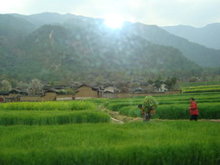 |
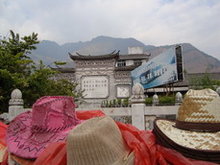 |
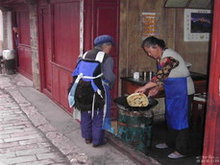 |
The road from Lijiang to Liming follows a small river. From the car, we enjoyed the view of several small villages, beautiful mountains and some blooming wild flowers. We took a few pictures when we passed the first bend in the Yangze river. Not far from there, we visited the “Stone Drum Town”, which features the famous Tiehong bridge that was used on the Ancient Tea-Horse Road. There is also a monument for the Red Army's River Crossing during the Great March in 1936. We found it a very significant place to visit, both, in terms of scenery and history. On the way we also discovered many interesting local snacks like brown candy and bean jelly.
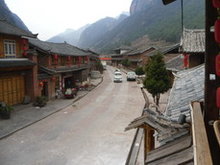 |
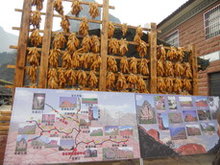 |
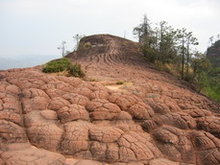 |
Upon arriving in Liming (3 hours by van), it was time for lunch. After devouring some delicious local specialties, we checked into a cosy guesthouse and rested for a while. In the early afternoon we went out for some mountain climbing over the “thousand tortoise trail”. It wasn't easy, but we retained optimism because of the inspiring mountain landscape all around us. We tried to encourage each other as much as possible as the incoherent estimates by the locals where typically way out of range and didn't give us any idea about the actual distance to the top.When we arrived at the top we were truly stunned by the invigorating view ofthe valleys, villages and mountains below and around us.
 |
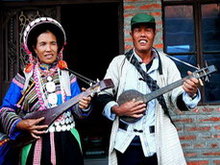 |
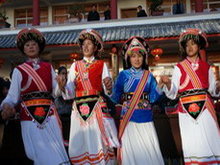 |
We walked down from the mountain and drove back to the guesthouse. After a short rest, we walked to the restaurant. In the evening we enjoyed an impressive dinner. The vegetables were all organically cultivated by our Lisu hosts. We were especially impressed by a kind of purple potato. Local people eat this when they need a power boost. After that we participated in a colourful Lisu dancing party. Lisu men drink out of bowls and the women dress in their traditional minority clothing. There are 3 types of Lisu clothing, white, black and colouful. In the Nujiang area they usually wear the black and white version. Whereas in the Lijiang area Lisu wear the colourful version. Married women wear big silver earrings and use pears to decorate their headdress. The young girls wear red pieces of cloth with white shells in their hair.
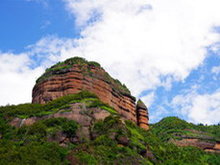 |
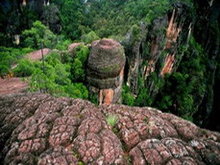 |
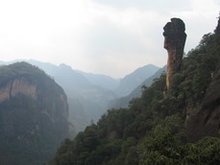 |
The next day our muscles were pretty sore, but we decided to continue hiking this time to another mountain named Anqini.From the top of this mountain you can look out over the colourful Danxia platform. We had breakfast at 8 'o clock and drove to the foot of the mountain in order to start our trek. In an hour and a half we reached the top of this impressive rock formation. We felt very small in contrast to the magnificent geographical features around us.
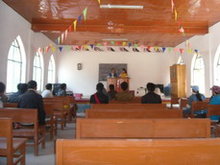 |
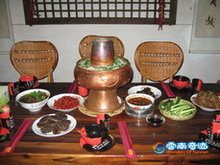 |
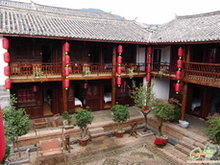 |
After lunch we drove back to Lijiang. On the way we passed a Christian church and witnessed some of their musical activities as it was Sunday. What was interesting here is that churchgoers sing in their native Lisu language. We also stopped on the road to experience the warm hearted hospitality of some local people. In the afternoon we arrived in Shuhe old town, next to Lijiang. Here we visited a local Naxi family. Our host was mister Li and apart from running a small restaurant, his hobby is writing the pictographic Dongba characters. He took the time to introduce us to the history and particularities of this unique script. His wife is called Jane and she loves to cook both traditional Naxi dishes as well as some unique fusion dishes with some Naxi flavor. We stayed in a peaceful and quiet guesthouse right in the center of Shuhe. The owner told us the house had more than a hundred years history but was originally built somewhere else. They physically moved the whole building from Longpang village (next to Jinsha river) to Lijiang in 1970. After the big earthquake (7 degrees) in Lijiang of 1996, the building remained the same with a small part damaged only, and it’s been moved to Shuhe in the year after, which was in 1997!
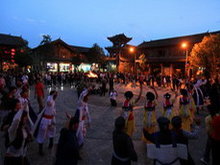 |
 |
 |
On our last morning we had a nice stroll in Shuhe and witnessed people washing dishes in the roadside streams. The willows flanking the streams gave a very peaceful impression. After our relaxed morning we drove to Baisha and visited the murals. This ancient wall art reflects the richness of the area’s history as we could distinguish cultural icons from all over China and other parts of Asia. It’s clear that the openness of the Naxi people has resulted in one of the most interesting cultural melting pots of China. After a delicious lunch, we paid avisit to the embroidery school in Baisha. The embroidery looked impressive and it was good to see how different generations of Naxi women teach each other how to make the embroidery. After Baisha, we went to the old town of Lijiang to have a stroll and dinner. It was way less quiet and peaceful experience than Shuhe, but never theless interesting. After dinner, we caught the train back to Kunming.
During this inspiring 4-day trip, we found out that inside the Lijiang area, there are still many undeveloped places where one can have a truly inspiring and unique experience. Places like Shuhe and Liming are very conveniently connected by the main roads running through Lijiang.
- 1408 reads
